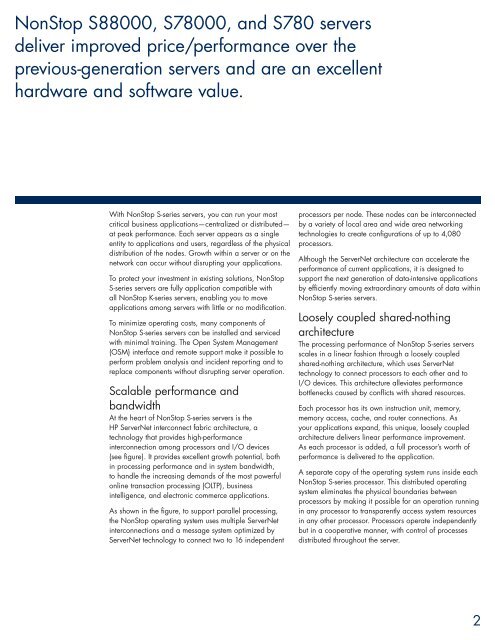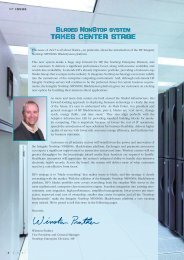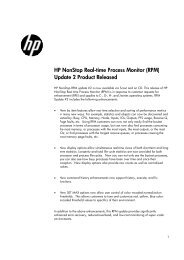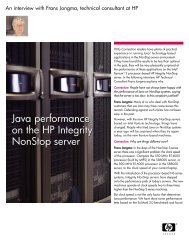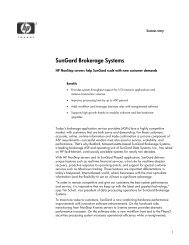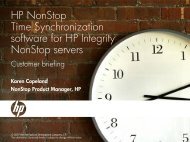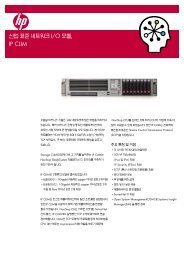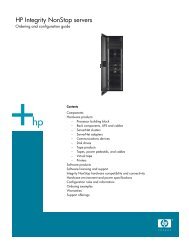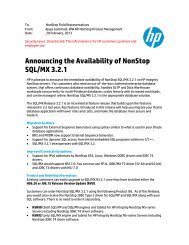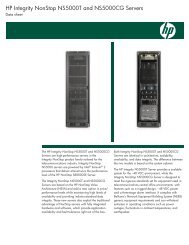HP NonStop Modular I/O subsystem data sheet - PDF (August 2004)
HP NonStop Modular I/O subsystem data sheet - PDF (August 2004)
HP NonStop Modular I/O subsystem data sheet - PDF (August 2004)
You also want an ePaper? Increase the reach of your titles
YUMPU automatically turns print PDFs into web optimized ePapers that Google loves.
<strong>NonStop</strong> S88000, S78000, and S780 servers<br />
deliver improved price/performance over the<br />
previous-generation servers and are an excellent<br />
hardware and software value.<br />
With <strong>NonStop</strong> S-series servers, you can run your most<br />
critical business applications—centralized or distributed—<br />
at peak performance. Each server appears as a single<br />
entity to applications and users, regardless of the physical<br />
distribution of the nodes. Growth within a server or on the<br />
network can occur without disrupting your applications.<br />
To protect your investment in existing solutions, <strong>NonStop</strong><br />
S-series servers are fully application compatible with<br />
all <strong>NonStop</strong> K-series servers, enabling you to move<br />
applications among servers with little or no modification.<br />
To minimize operating costs, many components of<br />
<strong>NonStop</strong> S-series servers can be installed and serviced<br />
with minimal training. The Open System Management<br />
(OSM) interface and remote support make it possible to<br />
perform problem analysis and incident reporting and to<br />
replace components without disrupting server operation.<br />
Scalable performance and<br />
bandwidth<br />
At the heart of <strong>NonStop</strong> S-series servers is the<br />
<strong>HP</strong> ServerNet interconnect fabric architecture, a<br />
technology that provides high-performance<br />
interconnection among processors and I/O devices<br />
(see figure). It provides excellent growth potential, both<br />
in processing performance and in system bandwidth,<br />
to handle the increasing demands of the most powerful<br />
online transaction processing (OLTP), business<br />
intelligence, and electronic commerce applications.<br />
As shown in the figure, to support parallel processing,<br />
the <strong>NonStop</strong> operating system uses multiple ServerNet<br />
interconnections and a message system optimized by<br />
ServerNet technology to connect two to 16 independent<br />
processors per node. These nodes can be interconnected<br />
by a variety of local area and wide area networking<br />
technologies to create configurations of up to 4,080<br />
processors.<br />
Although the ServerNet architecture can accelerate the<br />
performance of current applications, it is designed to<br />
support the next generation of <strong>data</strong>-intensive applications<br />
by efficiently moving extraordinary amounts of <strong>data</strong> within<br />
<strong>NonStop</strong> S-series servers.<br />
Loosely coupled shared-nothing<br />
architecture<br />
The processing performance of <strong>NonStop</strong> S-series servers<br />
scales in a linear fashion through a loosely coupled<br />
shared-nothing architecture, which uses ServerNet<br />
technology to connect processors to each other and to<br />
I/O devices. This architecture alleviates performance<br />
bottlenecks caused by conflicts with shared resources.<br />
Each processor has its own instruction unit, memory,<br />
memory access, cache, and router connections. As<br />
your applications expand, this unique, loosely coupled<br />
architecture delivers linear performance improvement.<br />
As each processor is added, a full processor’s worth of<br />
performance is delivered to the application.<br />
A separate copy of the operating system runs inside each<br />
<strong>NonStop</strong> S-series processor. This distributed operating<br />
system eliminates the physical boundaries between<br />
processors by making it possible for an operation running<br />
in any processor to transparently access system resources<br />
in any other processor. Processors operate independently<br />
but in a cooperative manner, with control of processes<br />
distributed throughout the server.<br />
2


